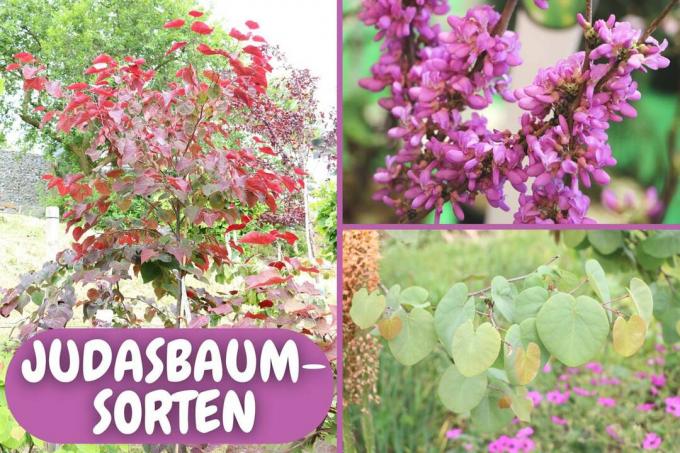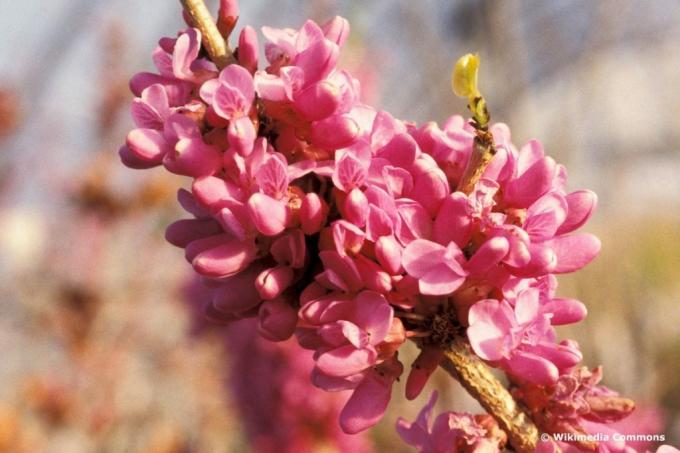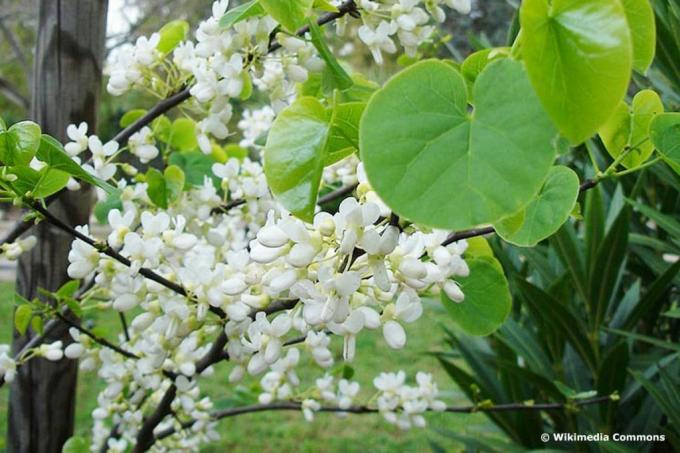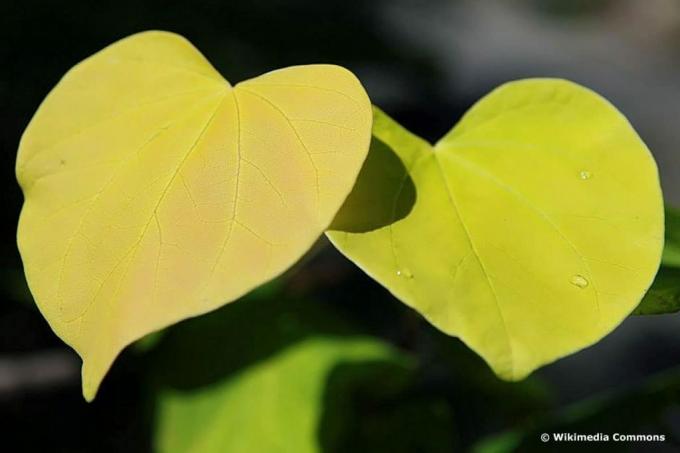
table of contents
- Botanical peculiarity
- Judas tree species
- Upright Judas Tree (Cercis glabra)
- Chinese judas tree (Cercis chinensis)
- Common Judas Tree (Cercis siliquastrum)
- Canadian Judas Tree (Cercis canadensis)
- frequently asked Questions
The Judas tree enchants in spring with its fascinating butterfly blossoms. It can also be used as a wedding present. The wood is definitely an eye-catcher in every garden. We introduce you to 20 varieties of Judas tree in more detail.
In a nutshell
- Wood with stem bloom
- Leaves appear after flowering
- Mainly cultivated in this country: Canadian, - Chinese, - common and upright Judas tree
- many varieties arose through breeding
Botanical peculiarity
The Judas tree (Cercis) is a botanical specialty, because the distinctive butterfly flowers of these trees bloom from the wood of the trunk and the branches. In botany this stem bloom is called cauliflora. The blossoms of all Judas trees attract bees and butterflies. The large, heart-shaped leaves appear only after they have bloomed. These often remain on the tree throughout winter and into spring. In autumn, the foliage impresses with its many bright colors. The leaf color is similar to that of
Wild wine (Parthenocissus quinquefolia). There are around 10 species worldwide, only a few of which are cultivated in this country. Below is a brief overview of these species with their different varieties.Note: Various legends have grown up around the name of the tree. The tree is said to have got its name after the apostle Judas Iscariot hanged himself on just such a tree after his betrayal of Jesus.
Judas tree species
In this country, four types of Judas trees are mainly cultivated. The most diverse varieties have been created through breeding:
Upright Judas Tree (Cercis glabra)

- Growth: upright, shrub-like
- Growth height: up to 400 cm
- Flowering period: April to May
- Flowers: pink are red, violet, standing in clusters
- Leaves: up to 20 cm long, heart-shaped, summer green, golden yellow autumn color
- Special features: freezes back in winter, suitable for gardens
Chinese judas tree (Cercis chinensis)

- Habit: upright, shrub-like, hardly grown as a tree
- Growth height: up to 400 cm
- Flowering period: April to May
- Flowers: purple to pink
- Leaves: green, rounded, deciduous
- Special feature: varieties of this type are well suited for keeping in pots
Chinese Judas tree "Avondale"

- Habit: large shrub or small trees, slow growing
- Growth height: 400 to 600 cm
- Flowering time: April
- Flowers: violet-pink, pink
- Leaves: upper side dark green, underside lighter, heart-shaped, tapering to a point, autumn color yellow
- Special feature: winter protection necessary
Chinese Judas tree "Don Egolf"

- Habit: upright shrub, compact habit. slowly growing
- Growth height: up to 300 cm
- Flowering period: April to May
- Flowers: pink
- Leaves: deciduous
- Special feature: winter protection necessary
Chinese Judas tree "Shirobana"
- Habit: upright shrub
- Growth height: up to 400 cm
- Flowering period: April to May
- Flowers: white
- Leaves: deciduous, round to heart-shaped
Common Judas Tree (Cercis siliquastrum)

- Habit: funnel-shaped shrub
- Height: 350 to 600 cm
- Flowering period: April to May
- Flowers: purple-pink, single flowers in racemes
- Leaves: green-blue, heart-shaped or kidney-shaped
Tip: The flowers of the Judas trees are edible. They are especially good in salads.
Common Judas tree "Alba"

- Habit: multi-stemmed shrub or tree, umbrella-like crown
- Growth height: 400 to 600 cm
- Flowering period: April to May
- Flowers: white flower clusters
- Leaves: heart-shaped with blunt tip, green upper side, gray-green underside, length and width 7 to 12 cm
Ordinary Judas tree "Bodnant"
- Habit: shrubby or small trees
- Height: up to 1200 cm
- Flowering period: April to May
- Flowers: dark red
- Leaves: light green
Ordinary Judas tree "Judas leaf"
- Habit: shrub or small tree
- Growth height: up to 600 cm
- Flowering period: April to May
- Flowers: purple-pink
- Leaves: deciduous
Common Judas tree "Rubra"
- Habit: shrub or tree
- Growth height: up to 800 cm
- Flowering period: April to May
- Flowers: dark red
- Leaves: gray-green
Canadian Judas Tree (Cercis canadensis)

- Growth: upright large shrub
- Height: 300 to 400 cm
- Flowering period: March to May
- Flowers: dark red, in racemes
- Leaves: heart-shaped, blood-red when budding, later dark red, with red-yellow grains in autumn
- Special feature: different types
Note: The “Forest Pansy” variety is particularly well known in Germany as the Canadian Judas tree.
Canadian Judas tree "Appalachian Red"

- Habit: Large shrub or multi-stemmed small trees with a broad crown and good branches, very densely bushy, expansive when old, fast growing
- Growth height: 450 to 500 cm
- Flowering period: April to May
- Flowers: purple-red, up to 1 cm large butterfly flowers, standing in clusters
- Leaves: heart-shaped or broadly rounded with a slightly pointed end, alternate, 8 to 14 cm long and up to 15 cm wide, smooth-edged, shiny, green in summer, yellow in autumn
- Special feature: extremely heat-tolerant
Note: Varieties of the Canadian Judas tree, which are primarily native to the northeastern United States, are often sold in the trade as American Judas trees and possibly also as American Judas trees. with the addition "var. texensis ”. In this article this applies to the varieties “Appalachian Red”, “Oklahoma” and “Traveler”. However, there are no real botanical differences.
Canadian Judas tree "Cascading Hearts"

- Habit: cascading, upright, broadly spreading with overhanging branches
- Height: 150 to 300 cm
- Flowering period: April to May
- Flowers: pink to lilac, single flowers in racemes
- Leaves: heart-shaped, yellowish green
- Special feature: elegant solitary plant
Canadian Judas tree "Hearts of Gold"

- Habit: broad, upright, large shrub or small tree, often multi-stemmed, fine, rounded, finely branched crown, orange-colored shoot tips
- Height: 300 to 500 cm
- Flowering period: March to April
- Flowers: pink-violet, calyx-shaped flowers in short racemes
- Leaves: heart-shaped, 4 to 6 cm long and 5 to 10 cm wide, golden yellow
- Special feature: works well in single position
Note: This variety of the Canadian Judas tree is often referred to as the "Gold Judas Tree" because of its leaf color.
Canadian Judas tree "Oklahoma"

- Habit: small trees with good branching, densely bushy, compact growing, very spreading
- Height: 400 cm
- Flowering period: March to April
- Flowers: bright wine-red to pink, up to 1 cm large butterfly flowers, standing in clusters
- Leaves: heart-shaped or broadly rounded, length: 7 to 12 cm, width: up to 15 cm, slightly pointed End, smooth-edged, leathery and shiny, red shoots, green in summer, purple-red to orange-colored Autumn colors
Canadian Judas tree "Pink Pom Poms"
- Habit: loose, upright with a broad crown, slow growing
- Height: 300 to 700 cm
- Flowering period: March to April
- Flowers: bright pink, double in tufts
- Leaves: kidney or heart-shaped. copper-colored shoots, light green in summer, yellow autumn colors
- Special feature: well suited for keeping in a bucket
Canadian Judas tree "Royal White"
- Habit: small tree, shrub, spreading, upright bushy, well branched
- Growth height: 500 to 700 cm
- Flowering period: March to April
- Flowers: white, simple funnel-shaped flowers
- Leaves: heart-shaped, pale green in summer, yellow in autumn
- Special feature: good specimen plant
Canadian Judas tree "The Rising Sun"
- Habit: multi-stemmed, shrub or small tree, well branched, upright, slightly square shape
- Height: 150 to 300 cm
- Flowering period: late April to early June
- Flowers: pink, small flowers in balls
- Leaves: heart-shaped with a short tip, with entire margins, yellow-green in spring, red-orange in summer, orange-purple autumn color
- Special feature: cultivation in large pots possible, particularly suitable for standing alone or in groups, goes well with rose bushes
Canadian Judas tree "Traveler"

- Habit: small tree, well branched, very densely bushy, overhanging, weeping branches, very broad and spreading
- Growth height: 250 to 300 cm
- Flowering period: April to May
- Flowers: pink-pink, 1 cm large butterfly flowers in clusters
- Leaves: broadly round or heart-shaped, length: 7 to 12 cm, width: up to 15 cm, smooth-edged, slightly pointed end, leathery, shiny, red shoots, later green, yellow-orange autumn color
- Special feature: very robust and hardy
Tip: Judas trees should always be planted between October and March, but never in frosty weather or in excessive heat.
Cercis reniformis "Texas White"
This is a rare variety of the Canadian type of Judas tree from the USA. In this country it is still a rarity in the gardens.
- Growth: broadly spreading, upright, well branched
- Height: 200 to 300 cm
- Flowering period: April to May
- Flowers: creamy white, orchid-like flowers about 1 cm in size, in racemes
- Leaves: heart-shaped, sometimes also broadly round, length: 8 to 12 cm, width: up to 15 cm, pointed end, shiny, leathery dark green, yellow autumn color
- Special feature: good container plant
Note: After flowering, initially green seed pods up to 12 cm long form. They later turn light brown. They are slightly poisonous and should therefore not be consumed.
frequently asked Questions
The location should be sunny, warm and sheltered from the wind. The tree also grows in a partially shaded location, but not as nicely. The Judas tree does not tolerate waterlogging in the root area, so the soil should be well-drained and only slightly damp. In addition, these trees also love calcareous and moderately nutrient-rich soils.
After the growth, only moderate watering is necessary. These trees cope well with drought. In spring, a single dose of balanced complete fertilizer is sufficient to supply the wood with nutrients. Regular pruning is not necessary, only in urgent cases. However, sick and dead wood should be removed in summer. In winter, pruning measures are poorly tolerated.
As a rule, these trees become harder and harder with age. However, they should be given winter protection at low temperatures of around -10 ° C. The crown and trunk can be wrapped in jute or bast mats. In the root area, protection can be provided by applying a thick layer of leaves and brushwood.



